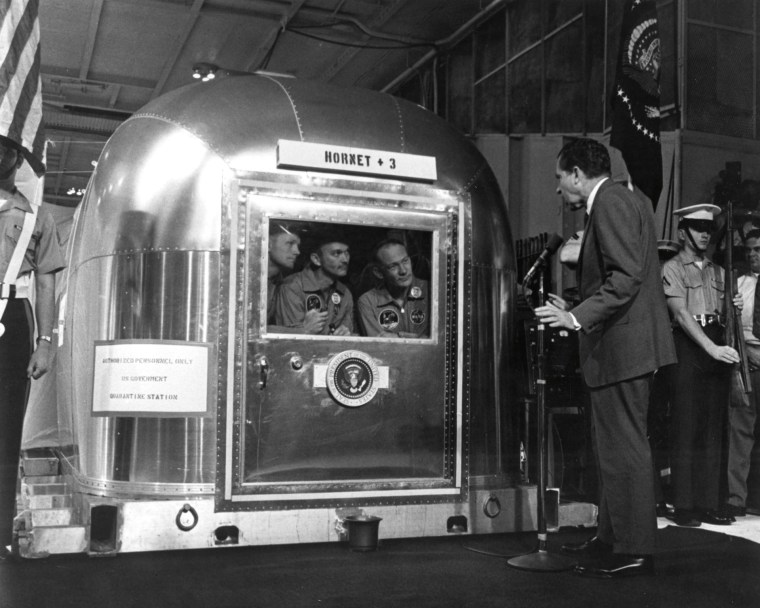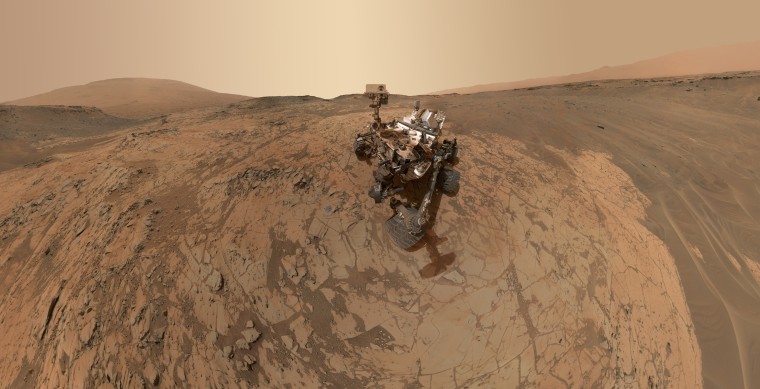From exploding rockets to the failure of life-support systems, a manned mission to Mars would present all sorts of dangers. One concern is that Mars might harbor microbes that could sicken visiting astronauts — and that the alien infection might spread to Earth when the astronauts return.
This is a threat that NASA has long considered. When Apollo 11 astronauts Neil Armstrong, Buzz Aldrin, and Michael Collins returned from their historic trip to the moon back in 1969, for example, they spent three weeks in quarantine on the off chance they were infected with unknown lunar microorganisms.

Today we think the moon is lifeless. But the question of whether Mars hosts living organisms — and possibly organisms that might pose a threat to life on Earth — remains an open one.
In the mid-20th Century, Carl Sagan and other scientists advocated for strict protocols for space missions to reduce the chance that alien organisms could get loose in Earth’s ecosystem. But the protocols have been controversial — and with NASA and SpaceX discussing plans to send humans to Mars, a long-standing debate over their importance is coming to a head.
How should we approach the future exploration of Mars? How should we go about sending astronauts to the red planet — and how soon?
Two-Way Protocols
The protocols specify that any samples brought back from another planet should be held within a special facility and that astronauts returning from interplanetary missions should be quarantined until it’s certain that they harbor no alien pathogens.
The protocols seem perfectly reasonable given our own experience right here on Earth. “We brought smallpox to the new world when the Europeans came over, and they took home syphilis,” says Dr. John Rummel, an astrobiologist who twice served as NASA’s planetary protection officer.
I’ve found that most taxpayers don’t want to pay for government programs that might kill them.
Given such facts, Rummel thinks it's possible that extraterrestrial microbes could harm astronauts and even people on Earth — and that citizens should be aware of the potential threat. “I’ve found that most taxpayers don’t want to pay for government programs that might kill them,” he quips.
Of course, the protocols are intended not just to protect life on Earth, but also to keep humans from spreading terrestrial life to other planets. Why worry about “infecting” other planets? Because that would compromise our ability to answer what is arguably the biggest question in science today: Are we alone in the universe?
If we discover microbes on another planet, we’d need to know if they were native to that planet — and not just germs inadvertently brought there by astronauts or some robotic craft.
Interplanetary paradox
It’s not an idle concern. NASA has already grappled with the possibility that its Mars rovers — which before leaving Earth underwent intensive cleaning procedures designed to render them sterile — might yet harbor bacterial spores that could seed terrestrial life on the red planet.
In 2016, the Curiosity Rover came within close range of dark streaks on the Martian surface. Scientists believed the streaks might be evidence of flowing water — and as we know, wherever there is water there might be life. And some scientists, including astrobiologist Dr. Alberto Fairén, a visiting scientist at Cornell University, wished that the rover could be steered over to the streaks to have a look.

But while the protocols allow the rovers to visit dry areas on Mars, they forbid the vehicles from venturing into potentially watery areas where life might exist.
It’s a disturbing paradox: We visit Mars to look for life, but we can’t visit the regions that might be especially likely to harbor it.
Stepwise exploration
Fairén argues that sending astronauts to Mars would render the protocols moot. After all, humans carry germs in and on their bodies — a thousand species of bacteria on our skin alone. In a new paper published in the journal Astrobiology, Fairén and his colleagues argue that the harsh conditions on Mars would probably kill any terrestrial bacteria or fungi that were to get there — and that, consequently, the protocols are pointless.
Other scientists disagree. They say that it’s impossible to know for sure that space vehicles or astronauts visiting Mars from Earth wouldn’t “infect” the red planet. And so Rummel is among those who advocate a stepwise exploration of Mars before astronauts ever set foot on the red planet.
That would mean, first of all, collecting samples of Martian rock and bringing them back to Earth for analysis. The next step might be to send astronauts not to Mars itself but to its moon Phobos, from which they would closely observe the Martian surface and deploy robots there — all without risk of contaminating it.
“I think it's a wonderful thing to want to send humans to Mars,” Rumell says. “But I don’t think we’re ready.”

